Miss Universe Philippines 2021 is all set to be held on 30th September 2021 at the Henann Resort Convention Center in Panglao, Bohol, where 30 stunning delegates from all over the country will compete for the national title and an opportunity to represent Philippines at Miss Universe 2021 pageant. The winner will succeed Miss Universe Philippines 2020 Rabiya Mateo for the title, who finished among the Top 21 at Miss Universe 2020, earlier this year.
The organization hosted the National Costume show on 23rd September 2021 at the Empire PH YouTube channel, where the shortlisted delegates paraded in their traditional costumes showing their culture and traditions. The theme was ‘Beauties of the past meet the wonders of the present’.
This year’s National Costume theme was a celebration of a bygone era of elegance and sophistication—the ‘Manila Carnival Queens’. They were the first Filipina beauty queens whose names are still remembered by historians and pageant aficionados. Their images wearing elaborate and intricate costumes live on in black and white photos. So, the organization wanted to bring these back to life and imagine how they would have looked today.
The delegate’s costumes were all masterfully created for them by world-class Filipino designers. It showcased the Filipina beauty, heritage, and artistry interpreted in modern, traditional, and avant-garde ways. Regardless of its interpretation, at the very core was the heart of a Filipina who is proud of her history, heritage, and country.
While all the divas dazzled in their national costumes, some attires stood out as they made it to our favourites for the National Costume competition this year. So, without any further ado, here are our Top 10 favourite National Costumes at Miss Universe Philippines 2021 –
Victoria Velasquez Vincent representing Cavite
Cavite’s Victoria looked divine wearing the National Costume designed by Nat Manilag reminiscent of the Manila Carnival Queen. The embroidery details represents the oldest standing structure of colonial baroque architecture in Cavite - The Nuestra Se?ora de Candelaria, more popularly known as the Silang Church. It was accentuated with pearls and feathers that gives varying textures and symbolizes the purity and illumination of a phenomenal woman.
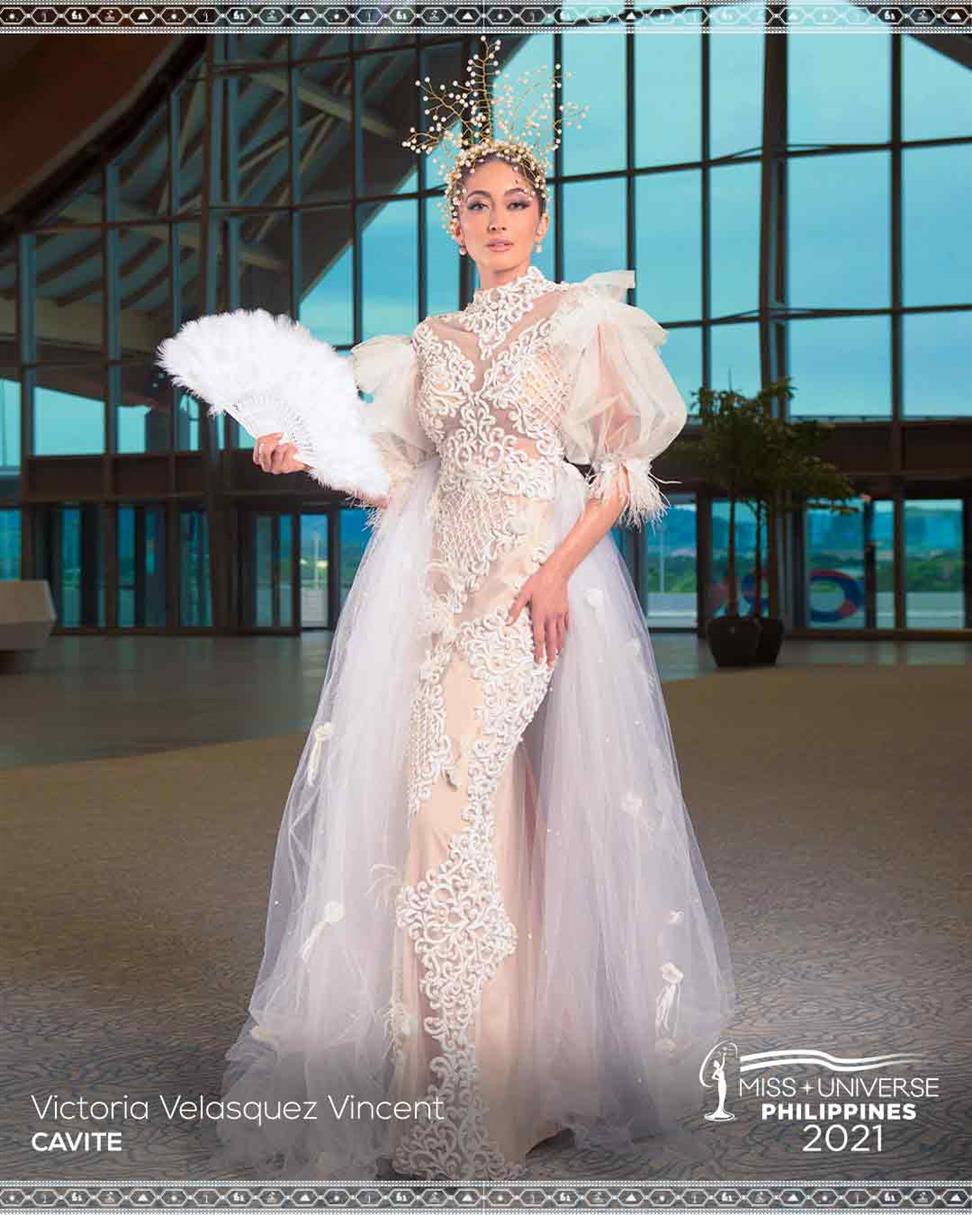
Leren Mae Bautista representing Laguna
The Manila carnival queen-inspired gown for Leren was designed by Chico Estiva and Renee Salud. It was made of fully beaded gold lame with over flowing long cape. The inner gown was made of hand woven gold fabric that fits to the body. It had long gold gloves to complete the look of a royal. The crown was made of golden leaves and foliage that Laguna is blessed with. The baculo matches with the golden crown that represents Leren, the woman with a golden heart.
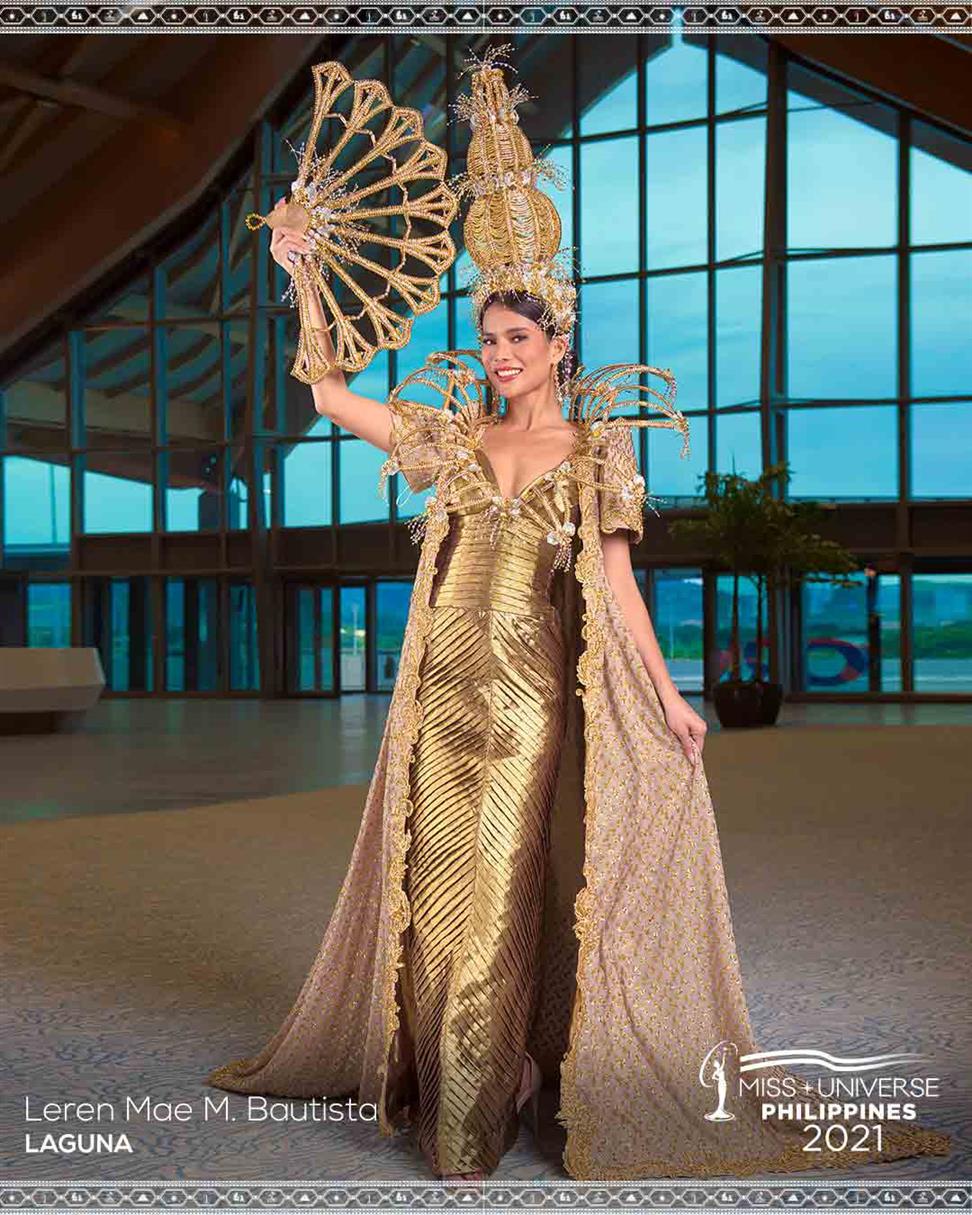
Maureen Wroblewitz representing Pangsinan
Maureen’s national costume designed by Louis Pangilinan was inspired by Pangasinan’s treasure, the Bangus. Nestled by the sea and traversed by seven rivers, this National Costume was designed to represent the hardworking fish traders of the Province that thrive amidst the Pandemic. The elaborated ensemble was executed in an all-silver avant-garde modern Filipiñana style that includes scale-like headdress, fish fin-structured train, and silver tassel that exhibits the seven rivers of Dagupan City. The silver beads, crystals, and sequins were hand-embellished as a representation of the rich and fine salt beds of the Province where it was derived and owed, ‘panag asinan’, where salt is made.
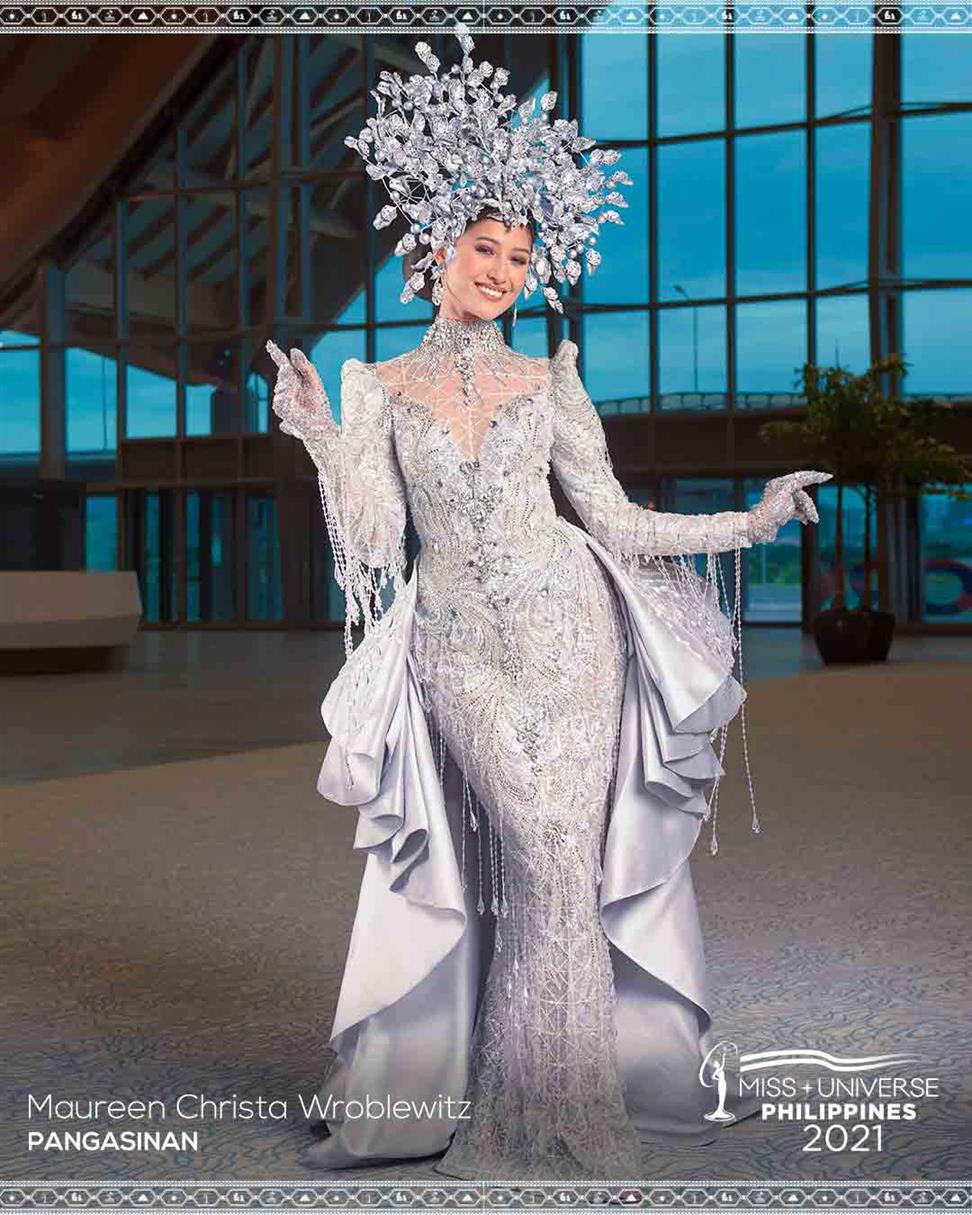
Izabelle Jasmine Umali representing Manila
Jasmine donned the stunning national costume, ‘Babayian’, designed by June Samson Pugat. The design takes inspiration from the Egyptian themed enthronement of Manileña, Carmen Papa y Arevalo, who was crowned Manila Carnival Queen in 1925. Instead of replicating the Egyptian motif, the design makes use of Pre-colonial religious iconography as reference for the embellishment. The costume features a column gown with terno sleeves and a two-panel watteau train which extends from the high neck Egyptian style collar.
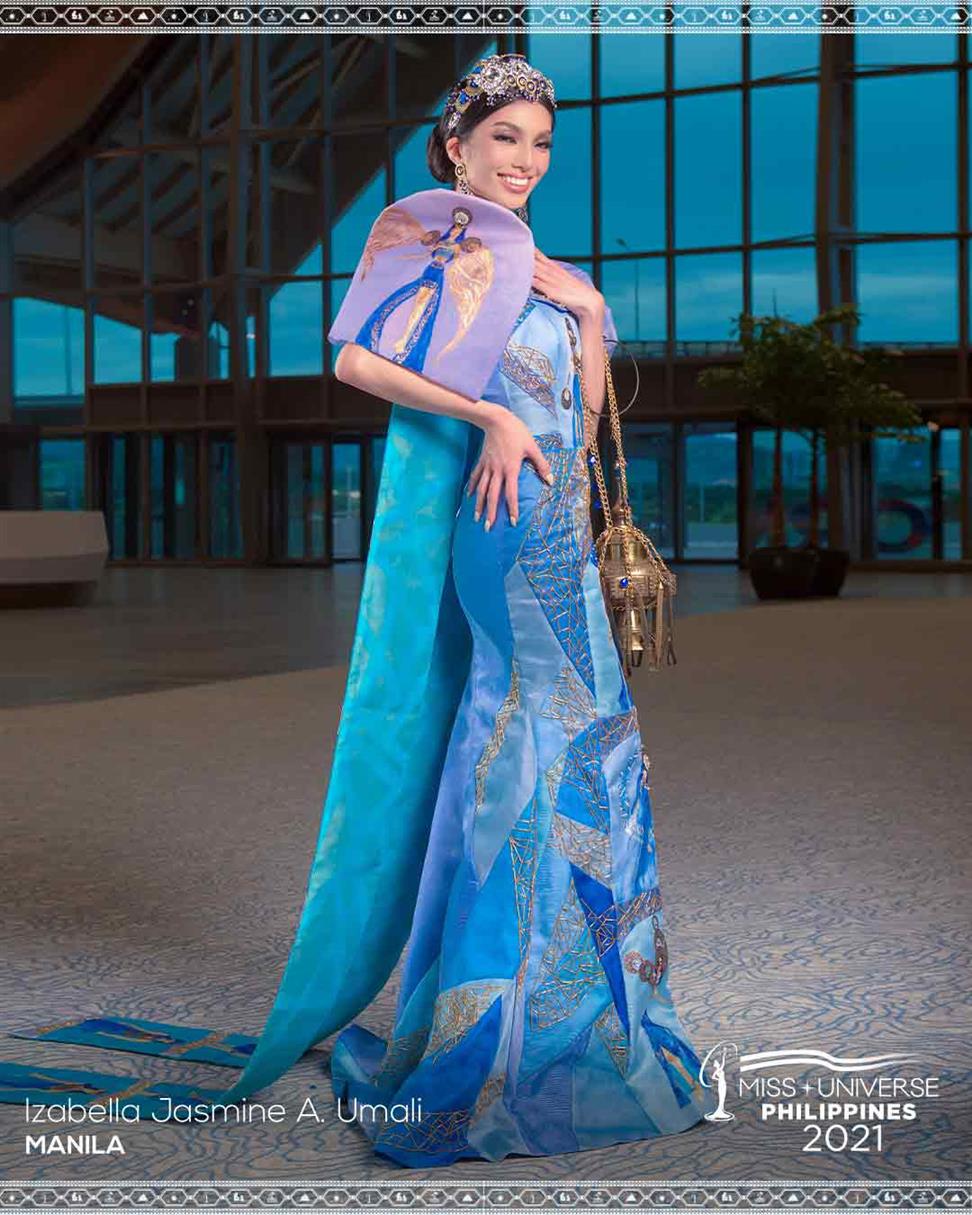
Beatrice Luigi Gomez representing Cebu City
Cebu City’s Beatrice Luigi wore the ‘Bakunawa: Moon Eater’ costume designed by Axel Que. The Philippines is abound with enthralling lore of epic adventures and mystical creatures, all of which have been passed down through generations from the ancestors. Tales that serve as unbreakable bonds that bind Filipinos to each and every descendant thereafter. One of the most captivating pieces of literature from the rich trove of folkloric history is the tale of the Bakunawa.
Bakunawa has been believed to have caused lunar eclipses, earning it’s notorious moniker: Moon Eater. The Bakunawa, beguiled by the 7 moon sisters’ beauty decided to devour them to satisfy its lust. When the 7th moon was about to swallowed up by the great serpent, Bathala intervened and told the people to bang pots & pans, which drove the beast away into the depths of the ocean. There the Bakunawa bides its time, hoping for another chance at fulfilling its sinister desire. And just like Bakunawa, the costume symbolized Beatrice’s rise.
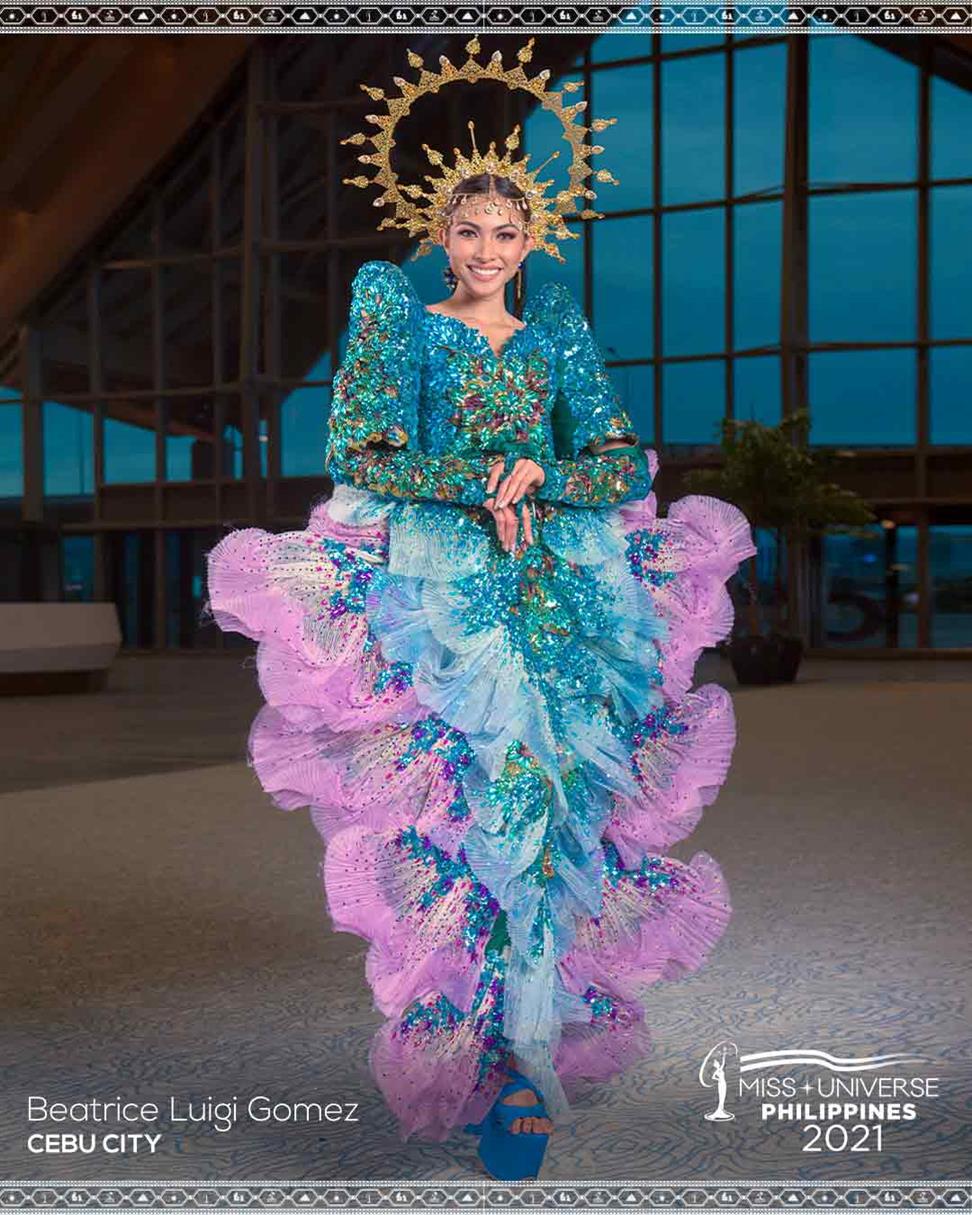
Grace Charmaine Vendiola representing Negros Oriental
A collaboration of amazing designers including Gerry Fernandez, Ting-ting Delfin and Marc Clifford Calumpang, Grace’s costume was a liberal interpretation of the manila carnival costume. A modern take on the traje de mestiza with details derived from the original de regor carnival costumes at that time. Decorative details are visualizations and a creative move where in utilization of indigenous materials on the carnival cape, superimposed with crystals, pearls and beads highlight the theatrical rendition of the manila carnival costume. To complete the regalia, a scepter, and crown recreates the rich coronation gowns of bygone era.
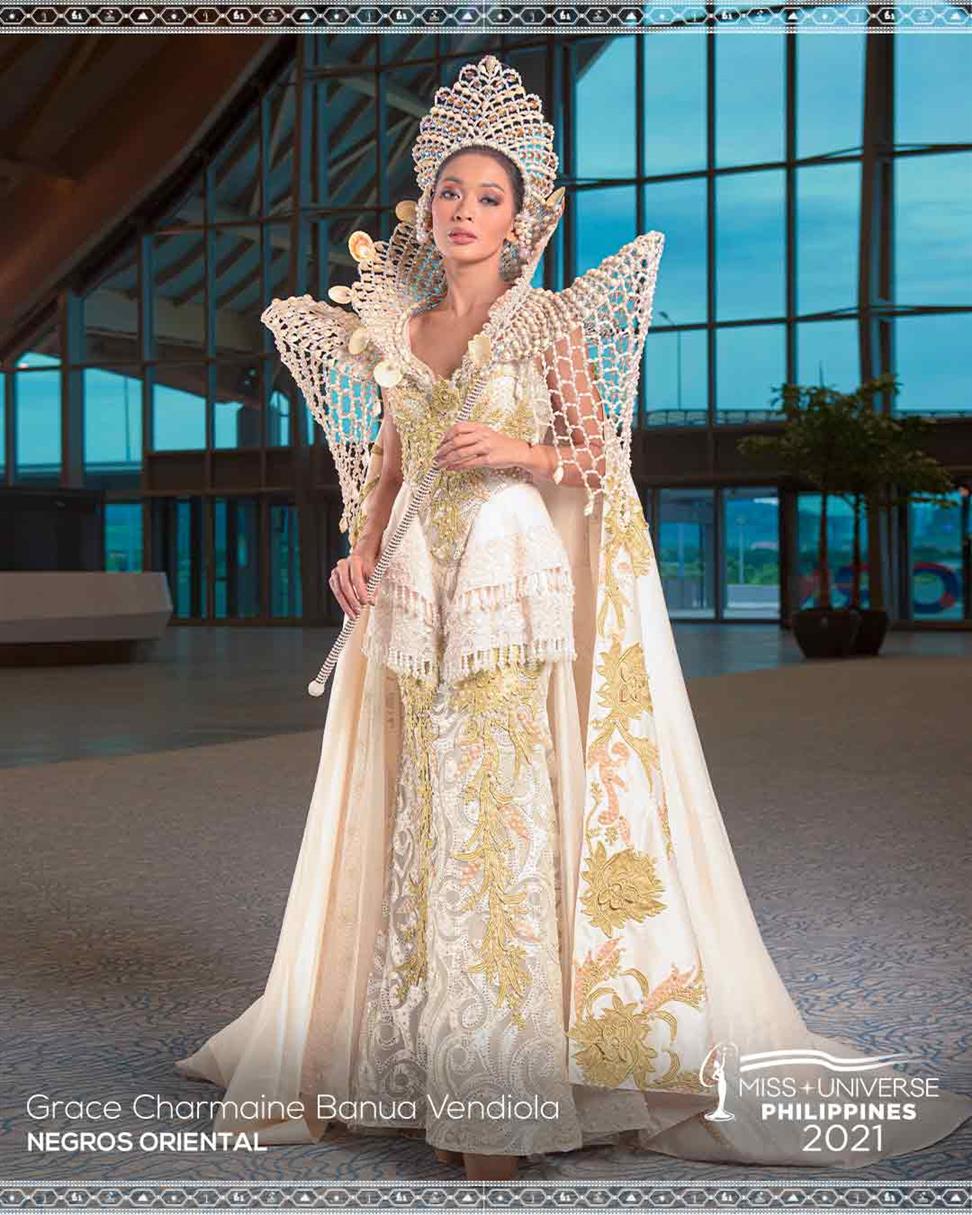
Princess Kristha Singh representing Pasig
Designed by Armand Marco, Kristha’s national costume was inspired by Pasig City slogan ‘Flowing with Hope’ or ‘Patuloy na Umaagos ang Pag-asa’ with an embodiment of a true Mutya Ng Pasig, interpreting the Philippine Carnival Queen during 1920's. The concept was inspired by Nicanor Abelardo’s lyrics, “Kung gabin ang buwan sa langit ay nakadungaw; The southwest seemed to wake him from his sleep in the water; A picture white and pristine, With loose hair as if flowing; This is the Jewel of Pasig.”
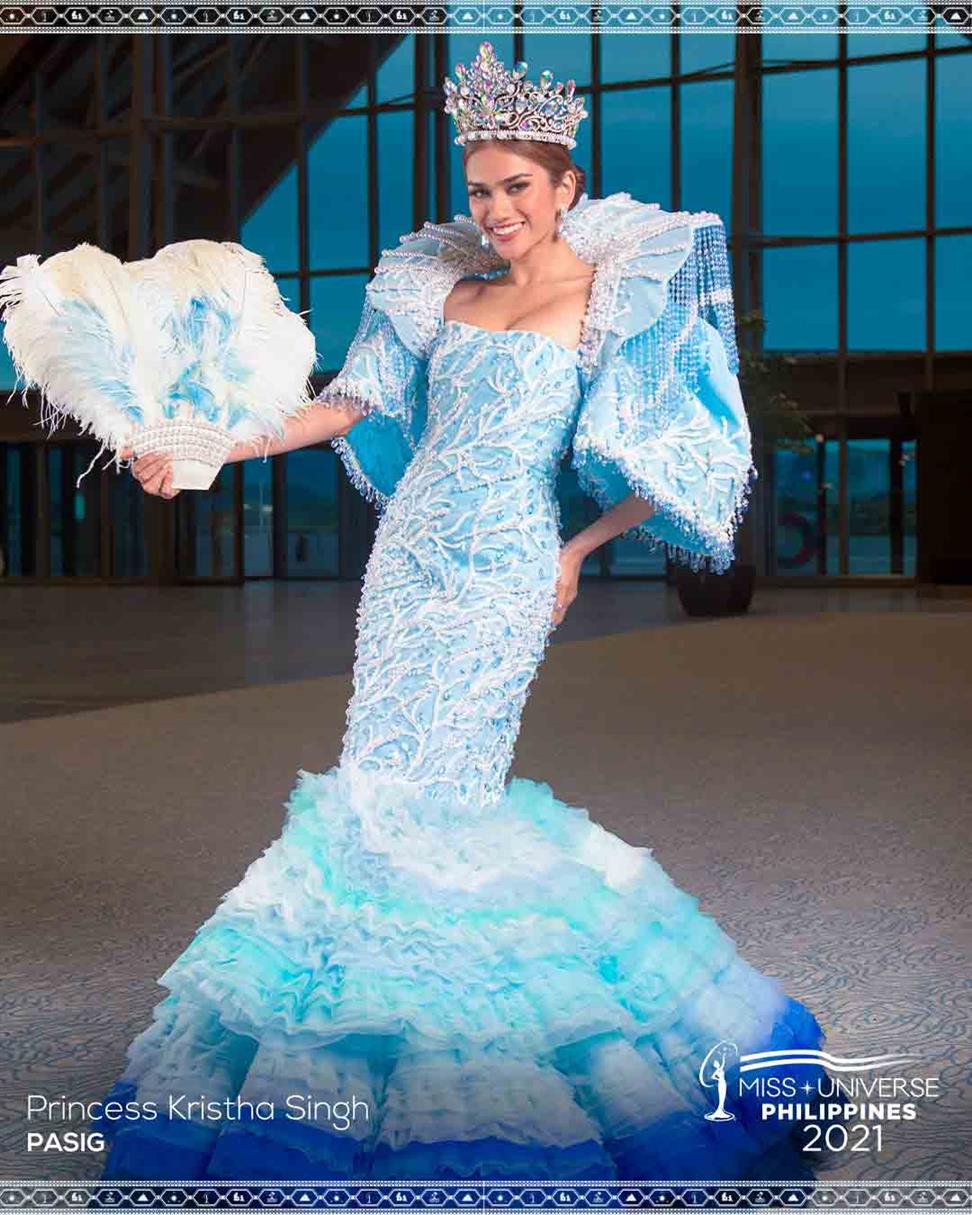
Steffi Aberasturi representing Cebu Province
Steffi Aberasturi donned the ‘Weaver of Hope’ costume designed by Malayka Yamas. As an advocate for empowering small businesses, her costume paid homage to a traditional Cebuano livelihood that's been more profound during the pandemic - Rattan weaving.
A legacy of immense craftsmanship that's been continued from generation to generation has been revived and given a modern take by the new generation of weavers. This represents how Cebuanos honor the past by using it to move forward, adapt, and innovate a better future. The intricate costume celebrates the 500 years of Christianity in the Philippines by honoring the colors of one of the most well-known religious relics of the Philippines - The Sen~yor Sto Nin~o.
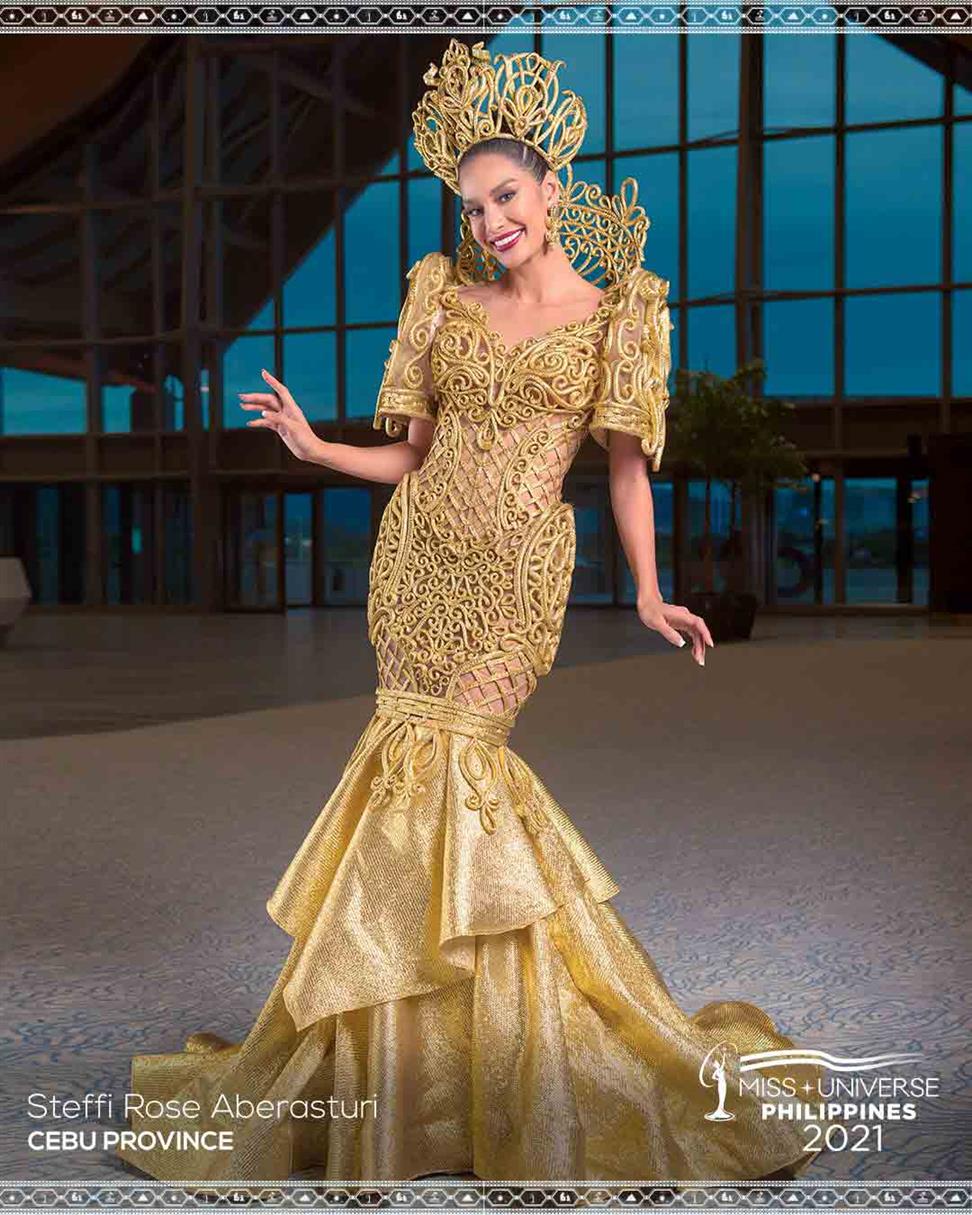
Katrina Dimaranan representing Taguig
Taguig’s Katrina Dimaranan wore the stunning lavender and white ombre gown by the amazing Tito Val Taguba. The gown was inspired by the regal and magnificent looks of the carnival queens, with the core inspiration being proud of Katrina’s personal story and her roots. The construction of the dress was inspired by ‘innovation’ and ‘transformation’ which is a representation of the Probinsyudad of Taguig. The shoulders were beaded chain accent which is Tito Val’s modern take on traditional butterfly sleeves. Looking closely, the designs were art-deco inspired; the popular design back when Manila’s Carnival Queen was happening as a tribute. Moreover, there was an intricate balance of areas exposing her skin which projects the balance of a woman’s softness, elegance, and charisma.
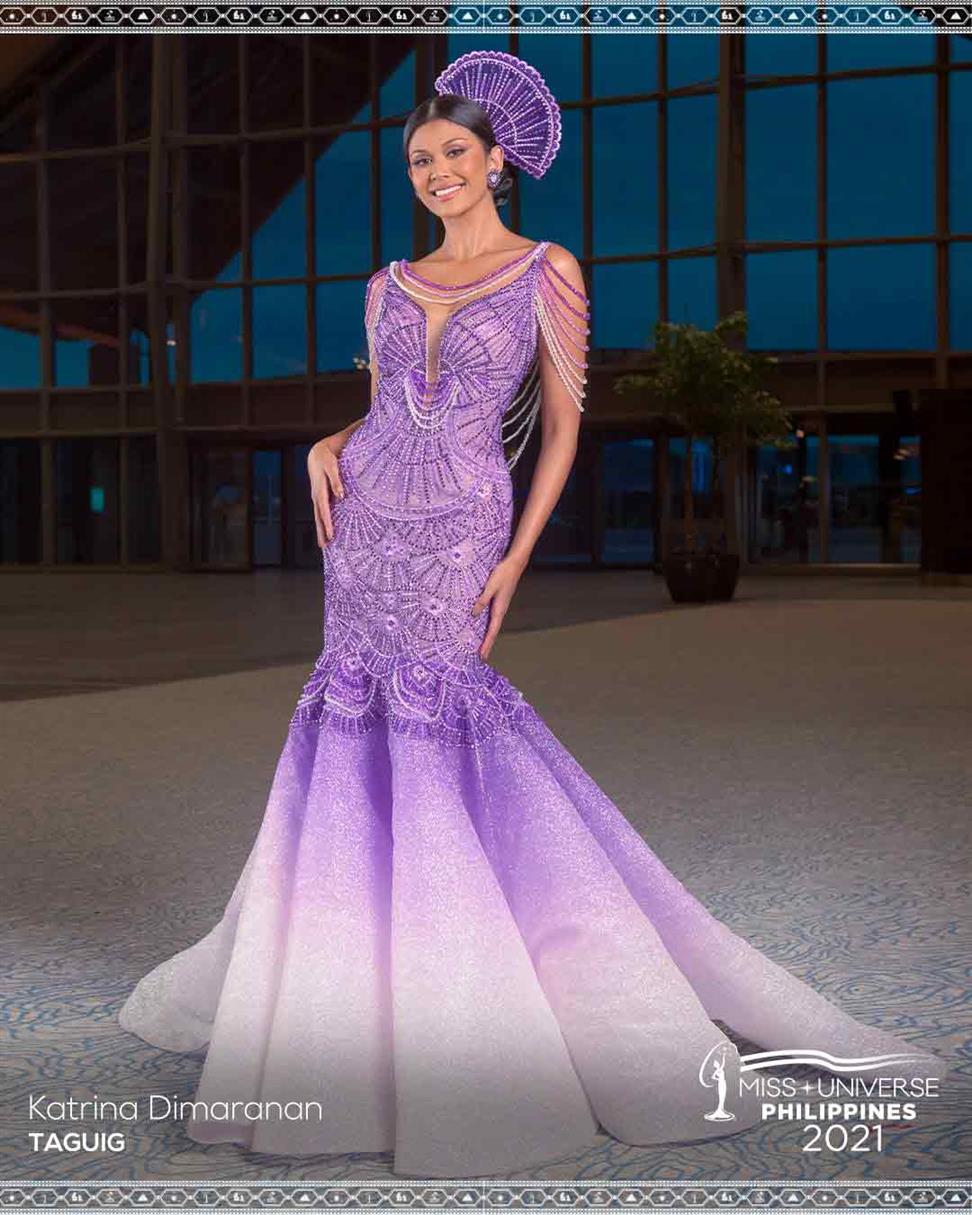
Isabelle De Los Santos representing Makati
Inspired by the Manila Carnival Queens and elevated by the country's national flower, the Sampaguita, Isabelle wore a modern barong-style ensemble by Oz Go. Making a national costume for the first time for a beauty pageant, Oz Go mentioned, “I had three ideas that I wanted to fuse with the inspiration. Barong tagalog, sampaguita, and pearls. Adding a modern twist to it but keeping the nostalgia of those days.”
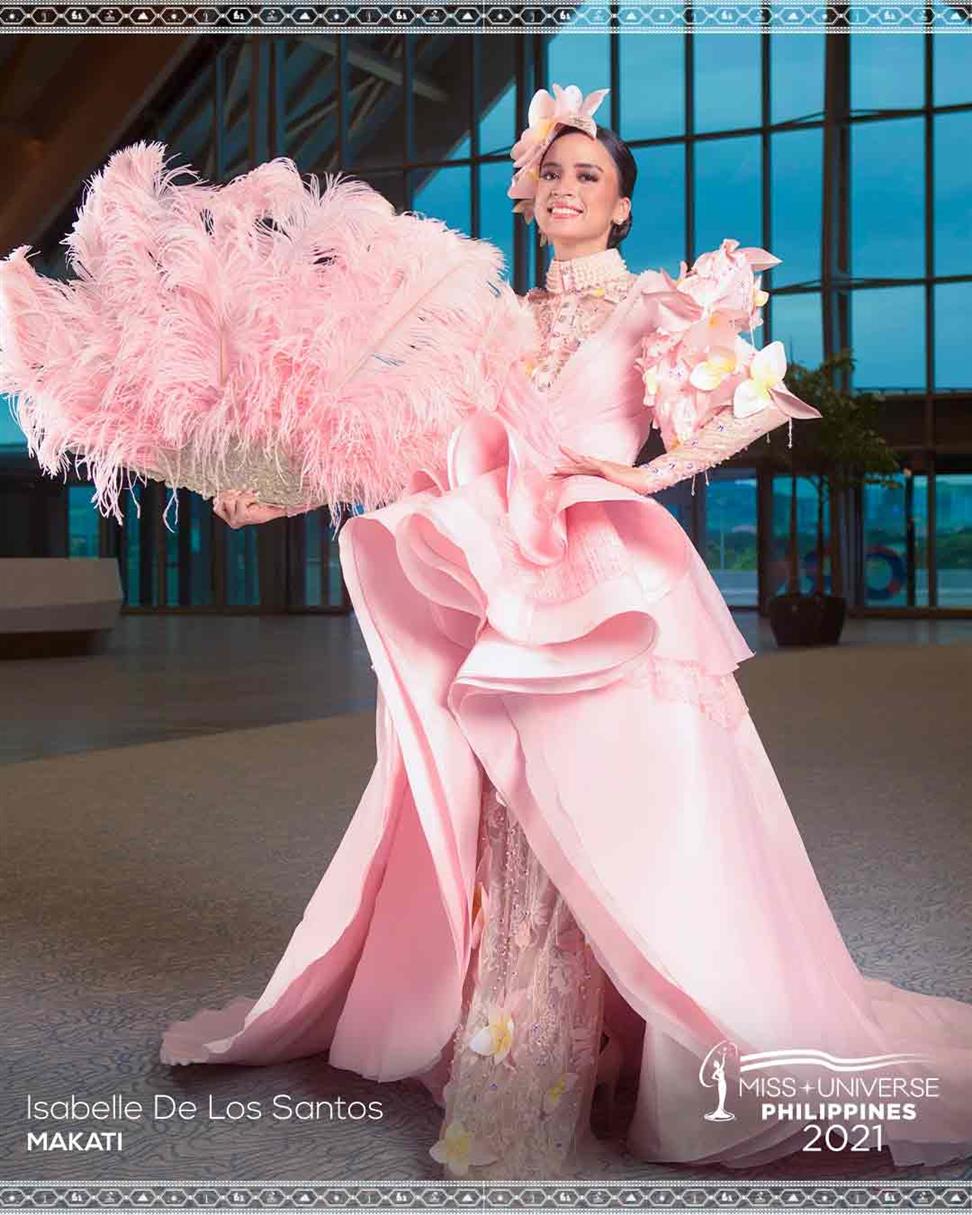
(Image Source: Miss Universe Philippines Official)